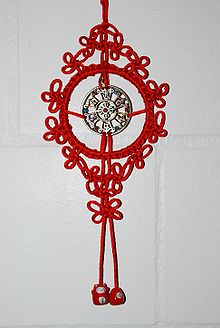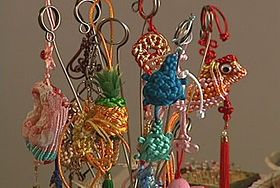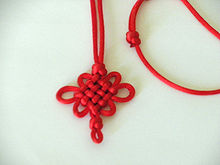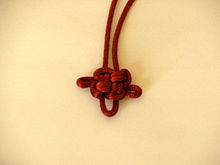- Chinese knotting
-
 Traditional Chinese Knots
Traditional Chinese KnotsChinese knotting (Chinese: 中國結; pinyin: Zhōngguó jié) is a decorative handicraft art that began as a form of Chinese folk art in the Tang and Song Dynasty (960-1279 AD) in China. It was later popularized in the Ming). The art is also referred to as Chinese traditional decorative knots.[1] In other cultures, it is known as "Decorative knots".
Chinese knots are usually lanyard type arrangements where 2 cords enter from the top of the knot and 2 cords leave from the bottom. The knots are usually double-layered and symmetrical.[2]
Contents
History
Archaeological studies indicate that the art of tying knots dates back to prehistoric times. Recent discoveries include 100,000-year old bone needles used for sewing and bodkins, which were used to untie knots. However, due to the delicate nature of the medium, few examples of prehistoric Chinese knotting exist today. Some of the earliest evidence of knotting have been preserved on bronze vessels of the Warring States period (481–221 BCE), Buddhist carvings of the Northern Dynasties period (317–581) and on silk paintings during the Western Han period (206 BCE–CE6).
Further references to knotting have also been found in literature, poetry and the private letters of some of the most infamous rulers of China. In the 18th century, one book that talked extensively about the art was Dream of the Red Chamber.[3]
The phenomenon of knot tying continued to steadily evolve over the course of thousands of years with the development of more sophisticated techniques and increasingly intricate woven patterns. During the Qing Dynasty (1644–1911) knotting finally broke from its pure folklore status, becoming an acceptable art form in Chinese society and reached the pinnacle of its success. Knotting continued to flourish up until about the end of imperial China and the founding of the Republic of China in 1911 AD when China began its modernization period.[1] From 1912 to the end of the Cultural Revolution in 1976, the art of Chinese knotting was almost lost.[1]
In the late 1970s, a resurgence of interest occurred in Taiwan, largely due to the efforts of Lydia Chen (Chen Hsia-Sheng 陳夏盛) of the National Palace Museum who founded the Chinese Knotting Promotion Center. In the 1980s, Mrs. Chen focused her energies on the knotting artifacts preserved during the Qing Dynasty. Currently, Chinese knotting enjoys wide popularity in Taiwan with numerous specialty shops to be found.
Regional
China
Historically knotwork are divided into cords and knots. In the dynastic periods, a certain number of craftsmen were stationed in the court and outside the court to produce cords and knots in order to meet the increasing demand for them at various places of the court. Cord, knot and tassels were made separated and combined later.
Hong Kong
Greatly influenced by western cultures, Chinese knotting crafts are almost invisible in the daily lives of Hong Kong Chinese. Yet, around the times of Chinese new year festival, you still can see Chinese knot decorations hanging on walls, doors of homes and as shop decorations to add some festival feel. Usually, these decorations are in red color, which traditional Chinese regards it as a color of "luck".
Korea
In Korea, decorative knotwork is known as maedeup (매듭), often called Korean knotwork or Korean knots. The origins of Maedeup date back to the Three Kingdoms of Korea in the first century CE. Maedeup articles were first used at religious ceremonies.[4] Inspired by Chinese knotwork, a wall painting found in Anak, Hwanghae Province, now in North Korea, dated 357 CE, indicates that the work was flourishing in silk at that time. Decorative cording was used on silk dresses, to ornament swords, to hang personal items from belts for the aristocracy, in rituals, where it continues now in contemporary wedding ceremonies. Korean Knotwork is differentiated from Korean embroidery. Maedeup is still a commonly practiced traditional art, especially amongst the older generations.
The most basic knot in Maedeup is called the Dorae or double connection knot. The Dorae knot is used at the start and end of most knot projects. There are approximately 33 basic Korean knots which vary according to the region they come from. [5] The Bong Sool tassel is noteworthy as the most representative work familiar to Westerners, and often purchased as souvenirs for macramé-style wall-hangings.
Japan
With greater emphasis on the braids that are used to create the knots, Japanese knotting (also known as hanamusubi) tends to focus on individual knots.
Types of knots
Lydia Chen lists 11 basic types of Chinese decorative knotwork in her first book. More complex knots are then constructed from repeating or combining basic knots. They are:
Name Alternate names Cloverleaf Knot 4 Flower Knot, Dragonfly Knot, Ginger Knot (Korean) Round Brocade Knot 6 Flower Knot Chinese Button Knot Knife Lanyard Knot, Bosun Whistle Knot Double Connection Knot Matthew Walker Knot Double Coin Knot Carrick Bend, Josephine Knot Sauvastika Knot Agemaki (Japanese) Cross Knot Friendship knot, Japanese crown knot Square Knot Plafond Knot 天花板結 Spectacle/Glasses Knot (Korean), Caisson Ceiling Knot Pan Chang Knot 盤長結 Coil Knot, Temple Knot, Chrysanthemum Knot (Korean), 2x2 Mystic Knot Good Luck Knot One major characteristic of decorative knotwork is that all the knots are tied using one thread, which is usually about one-meter in length. However, when finished the knot looks identical from both the front and back. They can come in a variety of colours such as; gold, green, blue or black, though the most commonly used colour is red. This is because it symbolizes good luck and prosperity.
There are many different shapes of Chinese knots. The most common being butterflies, flowers, birds, dragons, fish, and even shoes. Culturally they were expected to ward off evil spirits similar to bagua mirrors or act as good-luck charms for Chinese marriages.
Modern Adaptations
In February 2008, Corra Liew from Malaysia seeking possibilities out from the traditional wire jewelry making technique, Chinese knotting is then merged and presented in wire form. She calls the technique as Wired Chinese Knot.
Examples of transformed Chinese Knots:
Other
Chinese knot also refers to a game in which the players hold their arms together in a complex pattern, while a bystander tries to give them directions to untie their arms.
See also
References
- ^ a b c Chang, Zonglin. Li, Xukui. [2006] (2006). Aspect of Chinese culture. 中国文化导读. 清华大学出版社 publishing
- ^ www.chineseknotting.org
- ^ Chen, Lydia. [2003] (2003). Chinese Knotting: Creative Designs that are Easy and Fun. Tuttle Publishing. ISBN 0804833990
- ^ J. Van Rensburg, Elsabe, Knot Another!, Bangkok: Bleho Media, 2009. ISBN 6119020403[page needed]
- ^ J. Van Rensburg, Elsabe, Knot Another!, Bangkok: Bleho Media, 2009. ISBN 6119020403[page needed]
External links
Categories:- Decorative knots
- Arts in China
- Chinese art
Wikimedia Foundation. 2010.









